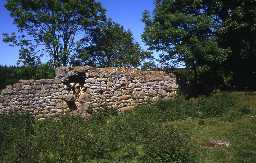Local History
Nunnykirk (Northumberland)
Nunnykirk lies in central Northumberland and lies between the high Fell Sandstones and the lower ground of the rivers Coquet and Font.
The earliest archaeological remains in the parish are two prehistoric enclosures. A circular enclosure at Ewesley Station and a rectangular enclosure may date to the Iron Age and could have been settlements or animal enclosures.
Nunnykirk lies north of Hadrian's Wall and no Roman remains have been found here. However, the prehistoric settlements mentioned above may have continued in use.
A rare early medieval find has come from the parish in the shape of the Nunnykirk Cross. It is probably ninth century in date and is similar to other crosses from the Hexham area. So far, no settlement has been found of this date.
In medieval times, much of the lands around Nunnykirk were granted to the Cistercian Newminster Abbey as monastic granges, such as Nunnykirk, East Ritton and Westritton. Other settlements included hamlets and villages such as Todburn where earthworks of house platforms and ridge and furrow fields can be seen. This area did not escape the effects of the wars between England and Scotland in medieval times and a tower was built at Nunnykirk.
Later, the effects of Border reivers in the 16th and 17th centuries meant that those who could afford it built defended farmhouses, called bastles, at Combhill Farmhouse, Ritton White House, South Healey and Healey. Some of these buildings were converted into more comfortable farmhouses when the threat from reivers abated in the later 17th century.
Agricultural improvements at this time led to the building of new farms at Colt Park where buildings were designed to meet the needs of new developments in farming. Lime kilns were built at Whitehouse as part of these developments, providing lime for building and improving the soil. The arrival of the North British Railway in the 19th century provided an easy means of transport for a range of industries such as coal mining at Ewesley and Whitehouse Colliery. The very building of the railway necessitated the building of bridges such as the railway viaduct over the River Font. The secluded nature of Nunnykirk led to the building of Nunnykirk Hall, a country house by John Dobson.
The earliest archaeological remains in the parish are two prehistoric enclosures. A circular enclosure at Ewesley Station and a rectangular enclosure may date to the Iron Age and could have been settlements or animal enclosures.
Nunnykirk lies north of Hadrian's Wall and no Roman remains have been found here. However, the prehistoric settlements mentioned above may have continued in use.
A rare early medieval find has come from the parish in the shape of the Nunnykirk Cross. It is probably ninth century in date and is similar to other crosses from the Hexham area. So far, no settlement has been found of this date.
In medieval times, much of the lands around Nunnykirk were granted to the Cistercian Newminster Abbey as monastic granges, such as Nunnykirk, East Ritton and Westritton. Other settlements included hamlets and villages such as Todburn where earthworks of house platforms and ridge and furrow fields can be seen. This area did not escape the effects of the wars between England and Scotland in medieval times and a tower was built at Nunnykirk.
Later, the effects of Border reivers in the 16th and 17th centuries meant that those who could afford it built defended farmhouses, called bastles, at Combhill Farmhouse, Ritton White House, South Healey and Healey. Some of these buildings were converted into more comfortable farmhouses when the threat from reivers abated in the later 17th century.
Agricultural improvements at this time led to the building of new farms at Colt Park where buildings were designed to meet the needs of new developments in farming. Lime kilns were built at Whitehouse as part of these developments, providing lime for building and improving the soil. The arrival of the North British Railway in the 19th century provided an easy means of transport for a range of industries such as coal mining at Ewesley and Whitehouse Colliery. The very building of the railway necessitated the building of bridges such as the railway viaduct over the River Font. The secluded nature of Nunnykirk led to the building of Nunnykirk Hall, a country house by John Dobson.
N13811
UNCERTAIN
Disclaimer -
Please note that this information has been compiled from a number of different sources. Durham County Council and Northumberland County Council can accept no responsibility for any inaccuracy contained therein. If you wish to use/copy any of the images, please ensure that you read the Copyright information provided.
